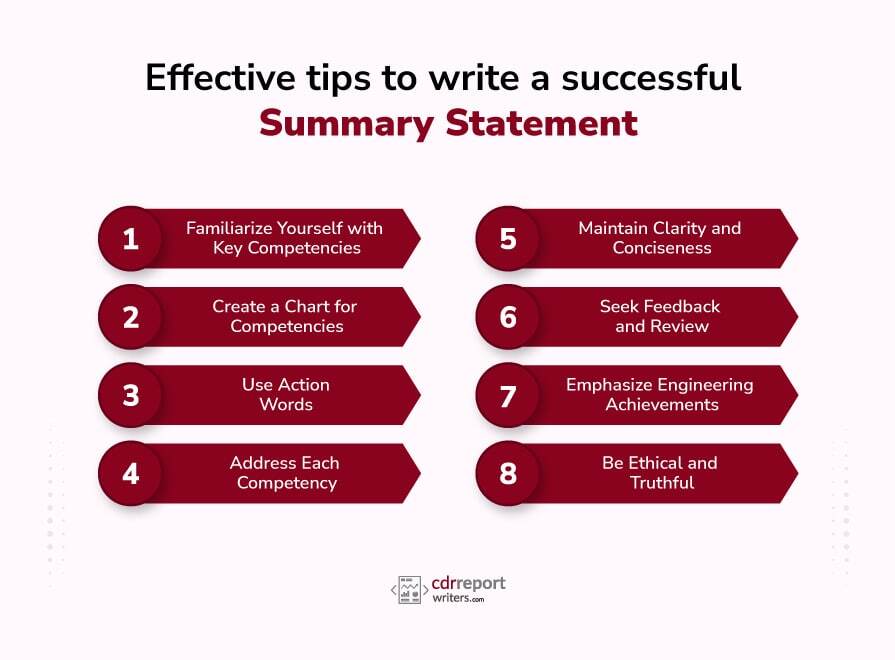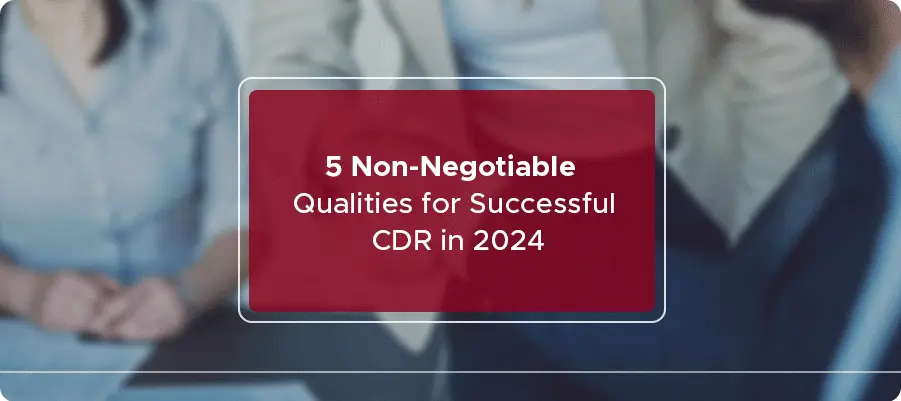
8 effective tips to write a successful Summary Statement
The Summary Statement briefly describes a CDR report’s competency units and elements. It highlights your core engineering skills and managerial abilities. Creating it in an easy-to-understand tabular format that connects well with your CDR episodes would be best.
You need to prepare three career episodes about your engineering work. After completing these episodes, you must review them to ensure they cover all the required competency elements. The Summary Statement reflects the outcome of this evaluation by matching competency elements with each paragraph in your career episodes.
You should download the appropriate summary statement template for your job category from Engineers Australia’s website. These templates are guides; you don’t have to limit your Summary Statement to one document. It’s optional to cover every metric in each competency aspect. Remember, you only need one effective Summary Statement for all three career episodes.
Understanding the CDR Report
Engineers Australia requires engineers to submit a CDR for the immigration or professional recognition process. It assesses an engineer’s qualifications and competencies, ensuring they meet the standards required to practice engineering in Australia. The CDR report consists of three main components:
1. Continuing Professional Development (CPD) List
This section records an engineer’s ongoing professional development activities. It includes details of courses, workshops, seminars, conferences, and any other educational activities undertaken to enhance their engineering knowledge and skills. Engineers Australia evaluates the CPD list to gauge an engineer’s commitment to staying current.
2. Three Career Episodes
The Career Episodes are detailed essays that engineers must prepare to showcase their engineering experiences and competencies. Each episode focuses on a specific period or project in the engineer’s career, highlighting their problem-solving abilities, technical expertise, teamwork, and leadership skills. These narratives should provide a clear picture of the engineer’s practical experience and their application of engineering principles in real-world situations.
3. Summary Statement
The Summary Statement connects the Career Episodes to Engineers Australia’s competency standards. It concisely summarizes how the engineer’s experiences align with these standards. It aids assessors in quickly identifying and evaluating an engineer’s competencies and achievements within the Career Episodes. Writing a perfect EA statement report can only be challenging with proper guidance and experience.
Many engineers aspire to further their education in Australia but must complete a series of assessments before working for an Australian company. The Competency Demonstration Report is a crucial aspect of pursuing a career in engineering in Australia.
To become eligible for an engineering career in Australia, you must meet all the criteria set by the Competency Demonstration Report. Regardless of your academic or professional achievements, your goal of working as an engineer in Australia may remain unfulfilled if you can’t meet these criteria. Therefore, it’s essential to comprehensively understand the Competency Demonstration Report before tackling it.
When creating your effective summary statement for Engineers Australia, remember that it should be both creative and engaging. Since the entire effective summary statement needs to fit into a single paragraph, ensure it covers all relevant information about your academic and professional experiences. Proper formatting is crucial, and you can find predefined formats online. It’s important to carefully read the instructions before writing your summary statement.
In your Engineers Australia summary statement, include all your accomplishments and achievements. This statement compares the entire summary report and the Competency Demonstration Report, which you must submit to Engineers Australia as part of the assessment process.
Learn More: Can an Engineering technologist get a PR Visa? ⏱⌛️
Effective tips to write a successful Summary Statement
The Summary Statement is separate from your CDR; it connects your Career Episodes and the competency standards Engineers Australia wants to see. Its main job is to show assessors how your career episodes show the skills they’re looking for.
Think of the Statement as a map. It helps assessors find specific paragraphs in your Career Episodes where you’ve shown each skill. Creating an effective Summary Statement requires understanding what these competencies detail.
1. Familiarize Yourself with Key Competencies
Engineers Australia has a list of critical competencies they want to see in your CDR reports. Understanding these competencies is crucial for writing a good Summary Statement. You must focus on five key competencies in your Summary Statement for Engineers Australia’s Competency Demonstration Report (CDR).
These competencies are what Engineers Australia looks for when assessing your engineering qualifications and skills. Let’s break them down in simpler terms:
- Knowledge and Skill Base: This is all about what you know and can do as an engineer, both in theory (the stuff you’ve learned) and in practice (how you apply that knowledge). It’s like showing you have the right tools in your engineering toolbox.
- Engineering Application Ability: Here, you need to demonstrate that you can take what you’ve learned and use it to solve real problems. It shows you can improve or solve tricky issues by applying your engineering knowledge.
- Professional and Personal Attributes: How you behave as an engineer. It would be best if you communicated professionally, which means talking and writing in a way that’s respectful and clear. It would be best to act ethically, making honest and fair decisions in your work. It’s like showing you’re not just good at engineering; you’re a trustworthy and respectful professional.
- Leadership and Management: If you’re in charge of projects or teams, you must show how you lead and make decisions. It’s about proving you can guide others and make intelligent choices when things get tough. This competency is for engineers who take on leadership roles.
- Sustainable and Ethical Practices: This is all about doing your engineering work in a way that’s good for the environment and follows ethical rules. It’s like showing that you care about the planet and are doing your part to ensure your engineering work doesn’t harm it.
In your Summary Statement, you must provide examples and evidence of meeting these competencies. It’s not just about saying you have these skills; you must prove it with real-life examples from your engineering work.
Remember, your effective Summary Statement is your chance to showcase your abilities and convince Engineers Australia that you have what it takes to be a successful engineer in Australia. So, take your time, gather evidence, and show them you’re the right engineer for the job!
Learn More: How effectively write and lodge an Expression of Interest (EOI)? 🧑🏽✈️🏆
2. Create a Chart for Competencies
Making a chart is helpful before you start working on your effective Summary Statement. This chart lists the key competencies Engineers Australia wants to see and shows where you’ve demonstrated each competency in your Career Episodes. Here’s a simple example of what it might look like:
- Knowledge and Skill Base: CE1 – Paragraph 2, CE2 – Paragraph 1, CE3 – Paragraph 3
- Engineering Application Ability: CE1 – Paragraph 4, CE2 – Paragraph 2
- Professional and Personal Attributes: CE1 – Paragraph 5, CE3 – Paragraph 6
- Leadership and Management: CE2 – Paragraph 3, CE3 – Paragraph 5
- Sustainable and Ethical Practices: CE3 – Paragraph 2
This chart helps you track where you’ve shown these competencies in your Career Episodes.
3. Use Action Words
To make your Summary Statement enjoyable, use action words. Start your sentences with strong verbs that show you did things actively in your projects. Instead of saying, “I was part of a team,” say, “I actively contributed to the team.”
For instance, instead of saying, “I was part of a team,” say, “I actively contributed to the team.”
4. Address Each Competency
Your Summary Statement should comprehensively address the critical competencies specified by Engineers Australia. For each competency, follow this structure:
- Begin with a Header: Start with a header that clearly states the competency you are addressing. For example, “Competency: Knowledge and Skill Base.”
- Provide Paragraph References: In the subsequent section, list the paragraph references from your Career Episodes where you have demonstrated this competency. Be specific and refer to the relevant paragraphs.
- Write an effective Summary Statement: Craft a concise statement describing how you demonstrated this competency in your engineering experiences. This statement should be a clear, well-structured statement highlighting your achievements and contributions.
- Use the Right Format: Engineers Australia provides specific formats for addressing each competency in your Summary Statement. Ensure that you follow these formats meticulously. These formats typically include elements like “Introduction,” “Engineering Activity,” and “Personal Engineering Activity.”
Here’s an example for addressing the competency “Knowledge and Skill Base”:
Competency: Knowledge and Skill Base
Paragraph References:
- CE1 – Paragraph 2
- CE2 – Paragraph 1
Summary Statement: In CE1, I demonstrated a solid knowledge base in structural engineering principles, particularly in analyzing complex structural systems. This statement was evident in Paragraph 2, where I discussed the detailed structural analysis I conducted for a high-rise building project.
Additionally, in CE2, Paragraph 1, I showcased my proficiency in finite element analysis software, which allowed for precise stress analysis and optimization of structural components. My ability to apply theoretical knowledge to practical engineering challenges is a testament to my sound knowledge and skill base.
Learn More: How to Write an ACS RPL Report for Database Administrator? ✈️✈️
5. Maintain Clarity and Conciseness
While providing enough detail to support your claims is essential, it’s equally crucial to maintain clarity and conciseness in your Summary Statement. Avoid unnecessary jargon or overly technical language that might confuse assessors. Use clear and straightforward language to communicate your achievements and competencies effectively.
Remember that assessors may review numerous CDR reports, so making your Summary Statement easy to read and understand is to your advantage. Be concise in your descriptions and focus on your career episodes’ most significant and relevant aspects.
6. Seek Feedback and Review
Like any professional writing, crafting an effective Summary Statement benefits from feedback and review. After you’ve written your Summary Statement, consider sharing it with colleagues, mentors, or professionals familiar with Engineers Australia’s requirements. They can provide valuable feedback on clarity, completeness, and alignment with the competency standards.
Additionally, proofread your Summary Statement meticulously to eliminate grammatical errors, typos, and formatting issues. Attention to detail is essential, as these minor errors can reduce the overall quality of your submission.
7. Emphasize Engineering Achievements
Your Summary Statement is a documentation of your competencies and an opportunity to showcase your engineering achievements and contributions. Be bold in highlighting your impact on projects, teams, or organizations. Discuss how your engineering expertise led to successful outcomes, improvements, or innovations.
When addressing competencies related to engineering application ability or leadership and management, provide specific examples of projects or initiatives where your contributions were instrumental. Use data, metrics, or testimonials to quantify and validate your achievements.
8. Be Ethical and Truthful
While it’s essential to emphasize your strengths and achievements in your effective Summary Statement, it’s equally critical to maintain the highest ethical standards and be truthful in your representation of your experiences. Engineers Australia strongly emphasizes ethical conduct, and any misrepresentation or fabrication of information can result in a negative assessment.
Ensure that all the information you provide in your Summary Statement is accurate, verifiable, and aligns with the content of your Career Episodes. Authenticity and honesty are fundamental principles of the engineering profession, and adhering to these principles in your CDR submission is essential.
Learn More: How to prepare CPD for your CDR Report? 🧑🏽✈️🏆
Conclusion
Creating an effective Summary Statement for your Engineers Australia Competency Demonstration Report (CDR) is a meticulous process. Following the ten tips outlined in this comprehensive guide, you can create a Summary Statement that aligns with Engineers Australia’s requirements and effectively showcases your engineering competencies, experiences, and achievements.
Remember, your CDR report, including the effective Summary Statement, is more than a paper to get graded. It tells the story of your journey as an engineer and shows how dedicated you are to your profession.
Approach the task diligently, seek feedback, and ensure your Summary Statement portrays your capabilities and contributions. With a well-crafted Summary Statement, you’ll be on your way to achieving professional recognition and advancing your engineering career in Australia.
Our experienced team of CDRReportWriters is dedicated to helping you succeed in your engineering career by ensuring your reports meet the highest standards. With our expert guidance and support, you can confidently present your skills and qualifications to the relevant authorities and organizations.






